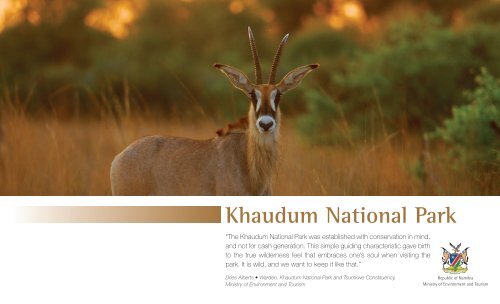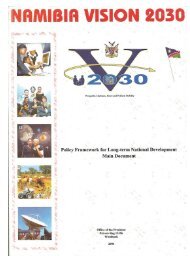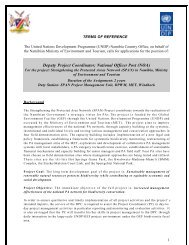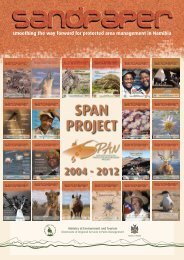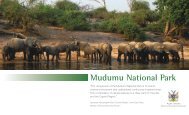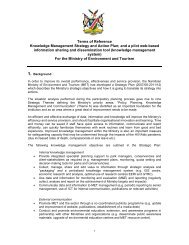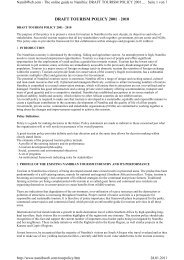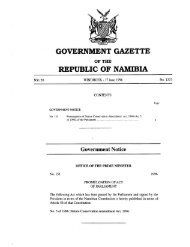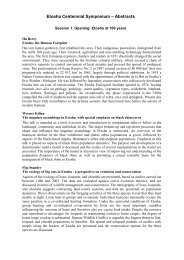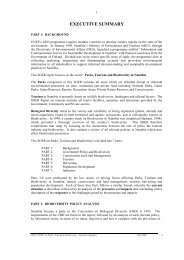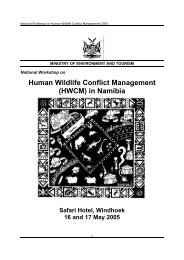Khaudum National Park - Ministry of Environment and Tourism
Khaudum National Park - Ministry of Environment and Tourism
Khaudum National Park - Ministry of Environment and Tourism
You also want an ePaper? Increase the reach of your titles
YUMPU automatically turns print PDFs into web optimized ePapers that Google loves.
<strong>Khaudum</strong> <strong>National</strong> <strong>Park</strong><br />
“The <strong>Khaudum</strong> <strong>National</strong> <strong>Park</strong> was established with conservation in mind,<br />
<strong>and</strong> not for cash generation. This simple guiding characteristic gave birth<br />
to the true wilderness feel that embraces one’s soul when visiting the<br />
park. It is wild, <strong>and</strong> we want to keep it like that.”<br />
Dries Alberts • Warden, <strong>Khaudum</strong> <strong>National</strong> <strong>Park</strong> <strong>and</strong> Tsumkwe Constituency,<br />
<strong>Ministry</strong> <strong>of</strong> <strong>Environment</strong> <strong>and</strong> <strong>Tourism</strong><br />
Republic <strong>of</strong> Namibia<br />
<strong>Ministry</strong> <strong>of</strong> <strong>Environment</strong> <strong>and</strong> <strong>Tourism</strong>
Discover the <strong>Khaudum</strong> <strong>National</strong> <strong>Park</strong><br />
Hidden away in Namibia’s north-eastern Kavango Region, the<br />
<strong>Khaudum</strong> <strong>National</strong> <strong>Park</strong> is not to be taken lightly. Rarely visited,<br />
very large, extremely wild <strong>and</strong> with only a rudimentary tourist<br />
infrastructure, it could be described as Namibia’s ‘forgotten wilderness’.<br />
If you have an adventurous streak, however, forgetting it<br />
would be a big mistake! Master the rugged 4x4 trails that weave<br />
through plains <strong>and</strong> thick Kalahari forests. The trails may come as a<br />
shock to those used to ‘the path well travelled’ – the park receives<br />
fewer visitors than elephants in a year. Relax at one <strong>of</strong> the state<strong>of</strong>-the<br />
art hides <strong>and</strong> enjoy watching the wildlife that congregates<br />
around the waterholes. The <strong>Khaudum</strong> is home to large herds <strong>of</strong> elephants<br />
<strong>and</strong> the African wild dog (Africa’s most endangered large<br />
predator). Listen, not only to the sounds <strong>of</strong> the wild, but also to the<br />
voices <strong>of</strong> the local people <strong>and</strong> <strong>Ministry</strong> <strong>of</strong> <strong>Environment</strong> <strong>and</strong> <strong>Tourism</strong><br />
personnel. In their stories <strong>of</strong> demon elephants, spirits, rescues,<br />
ordeals, struggle <strong>and</strong> strange events, the park comes alive.<br />
A borderless park<br />
Only the border with Botswana <strong>and</strong> a 55-km section <strong>of</strong> the western<br />
border <strong>of</strong> the park are fenced in the <strong>Khaudum</strong> <strong>National</strong> <strong>Park</strong>.<br />
This open-park system ensures that wildlife can pursue hereditary<br />
migratory routes to <strong>and</strong> from the water-rich Kavango River <strong>and</strong><br />
floodplains, including the Okavango Delta, a mere 150 km from<br />
the park boundary. Thus wildlife migratory routes link Namibia,<br />
Botswana <strong>and</strong> Angola under a protective legislative coat. In addition,<br />
the <strong>Khaudum</strong> is the only park in Namibia that protects the<br />
Northern Kalahari S<strong>and</strong>veld biome, portrayed as forest savannah<br />
<strong>and</strong> woodl<strong>and</strong>. Interspersed with flat, clay pans <strong>and</strong> a series <strong>of</strong><br />
omiramba, a Herero word meaning ‘vague river beds’ that provide<br />
water most <strong>of</strong> the year, the park attracts wildlife <strong>and</strong> visitors year<br />
round. Renown for its leopard population, the <strong>Khaudum</strong> <strong>National</strong><br />
<strong>Park</strong> is also one <strong>of</strong> the few refuges in which rare <strong>and</strong> endangered<br />
species such as roan antelope <strong>and</strong> African wild dog can roam freely,<br />
underlining the important conservation status <strong>of</strong> the park.
A long, varied history<br />
For millennia, the l<strong>and</strong> in <strong>and</strong> around where the <strong>Khaudum</strong> <strong>National</strong><br />
<strong>Park</strong> now st<strong>and</strong>s has been home to clans <strong>of</strong> hunter/gatherers.<br />
Yet with the disruption <strong>of</strong> traditional social systems, these<br />
groups inhabit a cultural hinterl<strong>and</strong> in conservancies <strong>and</strong> villages<br />
around the park that blends ancient <strong>and</strong> modern. Hunting within<br />
park boundaries is prohibited but conservation-driven community<br />
development is fuelled by the existence <strong>of</strong> the <strong>Khaudum</strong> <strong>National</strong><br />
<strong>Park</strong>. The absence <strong>of</strong> fences allows free movement <strong>of</strong> wildlife into<br />
locally owned l<strong>and</strong>, enhancing tourism potential <strong>and</strong> providing<br />
much-needed income to communities. The Gciriku Traditional Authority,<br />
Muduva Nyangana <strong>and</strong> George Mukoya conservancies will<br />
soon benefit directly from the two tourist camps within the park,<br />
Sikeretti Camp in the south <strong>and</strong> <strong>Khaudum</strong> Camp in the north. Entering<br />
an age <strong>of</strong> conservation where the protection <strong>of</strong> wildlife <strong>and</strong><br />
the support <strong>of</strong> rural communities goes h<strong>and</strong> in h<strong>and</strong>, these camps<br />
will be privately run in conjunction with the local conservancies.<br />
Off the beaten track<br />
The <strong>Khaudum</strong> <strong>National</strong> <strong>Park</strong> is all about adventure, <strong>and</strong> half <strong>of</strong> the<br />
adventure is simply getting there! The <strong>Ministry</strong> <strong>of</strong> <strong>Environment</strong><br />
<strong>and</strong> <strong>Tourism</strong> recommends a minimum <strong>of</strong> two vehicles per party,<br />
provisions for three days <strong>and</strong> 100 litres <strong>of</strong> water per vehicle per<br />
day. Travel is slow, heavy on fuel, <strong>and</strong> your 4x4 must be constantly<br />
engaged. Within the park, tracks tend to follow omurambas or link<br />
several waterholes together. There are two access points to <strong>Khaudum</strong><br />
<strong>National</strong> <strong>Park</strong>. From the south you can enter via the Tsumkwe<br />
road. From the north, use the Katere road. All roads, including the<br />
access points, require 4x4 vehicles, due to heavy, loose s<strong>and</strong>. There<br />
is no fuel available in the park. The closest fuel stations are Grootfontein<br />
(360 km from Sikeretti camp), Tsumkwe (only provides Diesel<br />
<strong>and</strong> Petrol 93 leaded type – 60 km from Sikeretti Camp), Rundu<br />
(170 km from <strong>Khaudum</strong> Camp) <strong>and</strong> Bagani/Divundu (150 km from<br />
<strong>Khaudum</strong> Camp). There is a state clinic on the Katere-<strong>Khaudum</strong><br />
camp road that is approximately 37 km from <strong>Khaudum</strong> Camp.
<strong>Environment</strong>al Care Code<br />
Please adhere to the following:<br />
• Be cautious <strong>of</strong> elephants <strong>and</strong> keep well away from breeding herds.<br />
• For your own safety, travel in the park with a minimum <strong>of</strong> two<br />
4x4 vehicles.<br />
• Remove all your rubbish from the park.<br />
• Light fires only in designated camping areas.<br />
• Stay on established roads <strong>and</strong> tracks.<br />
• Keep to the rules <strong>and</strong> regulations listed on your permit.<br />
Enjoy the adventure!<br />
Facilities:<br />
Basic camping facilities exist at Sikeretti <strong>and</strong><br />
<strong>Khaudum</strong>, yet keep in mind that for supplies<br />
the nearest places are Grootfontein <strong>and</strong> Rundu.<br />
No fresh produce is available within <strong>Khaudum</strong><br />
or surrounding villages. The water at both<br />
<strong>Khaudum</strong> <strong>and</strong> Sikeretti is suitable for drinking.<br />
Be sure to drink plenty <strong>of</strong> water daily, as dehydration<br />
is common in these areas. At Tsumkwe<br />
(closest village to the <strong>Khaudum</strong>) the medical<br />
infrastructure is limited to a nurse.<br />
Fact File:<br />
Proclamation date: <strong>Khaudum</strong> Nature Reserve<br />
was proclaimed in 1989. In February 2007, the<br />
reserve was given national park status.<br />
Size: 3 842 km 2<br />
Rainfall: Approximately 436 mm <strong>of</strong> rain annually,<br />
starting November <strong>and</strong> lasting up to April.<br />
Temperature: Average minimum 7ºC during July<br />
(winter) <strong>and</strong> average maximum 38ºC. Temperatures<br />
can reach 45ºC during summer months.<br />
Number <strong>of</strong> waterholes: 12 (artificial), two natural<br />
fountains. All the watering holes can be<br />
reached by vehicle, as two-track roads interlink<br />
the park in its entirety. Most <strong>of</strong> the watering<br />
holes have hides from which tourists can safely<br />
view wildlife.<br />
www.met.gov.na<br />
Sponsored by:


